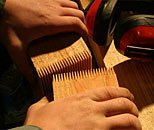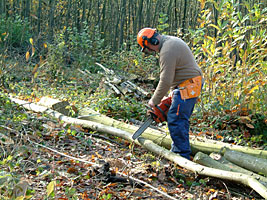Sweet Cluster

David Saunders/Woodnet - all photos except where otherwise credited
The prolific growth of sweet chestnut across the South East of England led to the original development as a building material. Here David Saunders, until recently director of the Flimwell Woodland Enterprise Centre, writes about how the chestnut material used in the Cluster exhibition originally came about.
The reality, however, is that the majority of woodland production is destined for far lower value uses - industrial fibre for panel boards, woodchips for fuel, or even humble logs – and the process of management and nurture of a forest means that there is inevitably a lot of low-grade production from thinnings during the cycle of decades needed to produce that high value stick of wood.
In Sussex, one of the most wooded counties in England, there is a long tradition of construction in wood, with large timbers used for houses and ship building, and the smaller diameter trunks used for fencing, hop poles and charcoal. The landscape we enjoy in the Weald today was created by centuries of sustainable management of the timber resources to meet local needs. As a renewable crop this process can continue in perpetuity, but in recent decades the momentum has slowed, largely due to the disappearance of traditional markets for the products from the coppices and shaws, and their substitution with imports from dubious sources, plastics and more modern, but fundamentally less sustainable, products for our buildings and items for everyday use.
 Many foresters and ecologists despair at the loss of timber value and the decline in traditional management that is the result, and woodland owners, unable to generate income from their woodland, close the gate and let neglect take over. Inevitably there has been some loss of habitat diversity that was previously created by the cyclical opening of the forest floor to light, and the varied canopy structures caused by coppicing and thinning.
Many foresters and ecologists despair at the loss of timber value and the decline in traditional management that is the result, and woodland owners, unable to generate income from their woodland, close the gate and let neglect take over. Inevitably there has been some loss of habitat diversity that was previously created by the cyclical opening of the forest floor to light, and the varied canopy structures caused by coppicing and thinning.At the Woodland Enterprise Centre at Flimwell, deep in the woods of the High Weald, in an attempt to address the challenges of loss of commercial viability efforts have been made over the past decade to invent new ways of adding value and creating new markets for these old woods. Innovation in building design, demonstrated by the techniques used in the construction of this contemporary gridshell building, has resulted in a fresh approach to using the small diameter trunks harvested through coppicing. By using modern wood engineering techniques high-value and durable building components for construction and cladding have been developed.
Sweet chestnut, in particular, has been the focus of this initiative as a south-east specialism, and one where the loss of markets for small-diameter hardwoods has hit hardest, impacting on both jobs and wildlife. Sweet chestnut is rapid in growth, and also produces a high proportion of durable heartwood at a very early age, and this short production cycle of 20 – 30 years can produce lengths of timber suitable for jointing and lamination into high quality, structural and durable hardwood elements, to equal the qualities of tropical timber, without the negative impact on the rainforest habitats. This environmental win-win opportunity is stimulating an architectural and design movement for substituting local timber for other more environmentally-damaging building materials, including energy-hungry concrete, steel and aluminium
 The experience of building the Woodland Enterprise Centre at Flimwell generated a new business - Inwood Developments, based at Whitesmith, near Lewes, which manufactures timber building components – laminated beams, gluelam arches, bespoke furniture and joinery components from locally-sourced timber generated by low-impact traditional woodland management.
The experience of building the Woodland Enterprise Centre at Flimwell generated a new business - Inwood Developments, based at Whitesmith, near Lewes, which manufactures timber building components – laminated beams, gluelam arches, bespoke furniture and joinery components from locally-sourced timber generated by low-impact traditional woodland management.The use of sweet chestnut ribbons, produced at the Whitesmith factory, signals a new direction for Annemarie O’Sullivan, a maker more used to the flexibility of willow wands to make baskets and sculptural forms. The challenge of using thin strips of sweet chestnut, cut from coppice and re-assembled into knot-free ribbons of wood has been met by the maker who has woven the clusters in such a way that both the flexibility and inherent tension of a living tree have been captured, inviting us to explore the means by which these structures hold together without fixings.
The fact that these artworks were made from locally-grown materials manufactured in Sussex is another example of how ingenuity and flair for design may inspire a fresh appreciation of the potential for wood.


Chestnut laths
